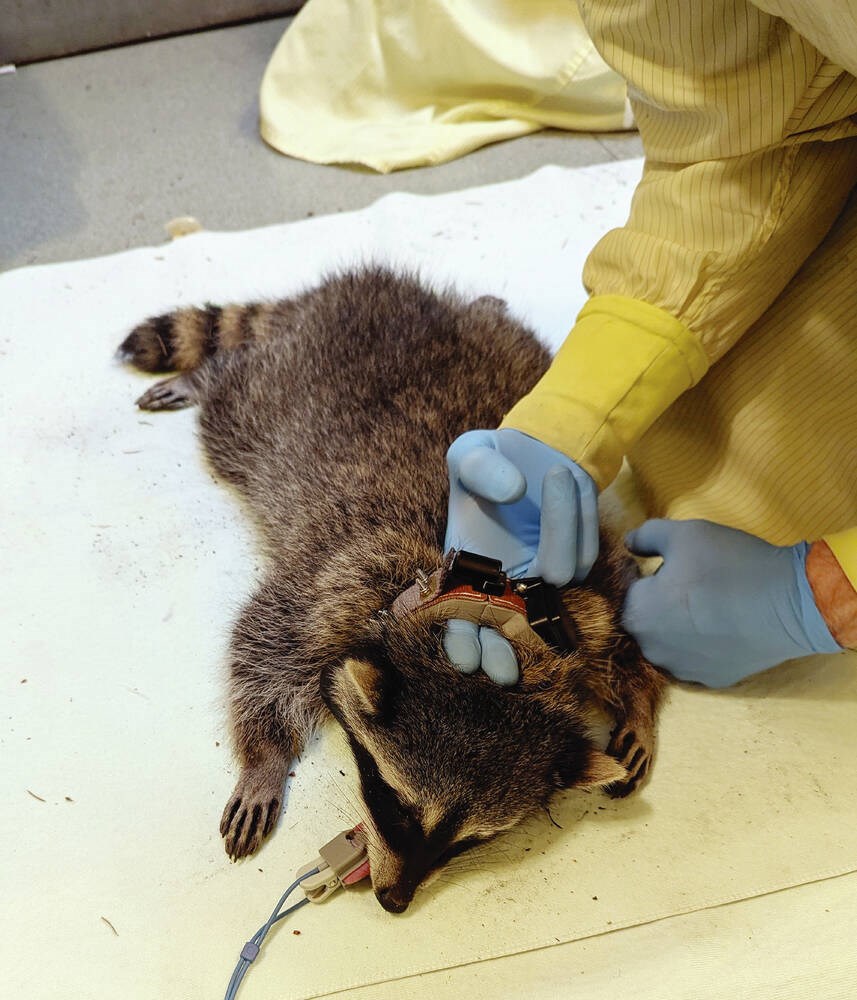Nine orphaned raccoons raised at the B.C. SPCA’s wild animal rehabilitation centre in Metchosin over the summer have been set free in the capital region, and are being tracked with GPS/radio collars.
The goal is for researchers to get a better understanding of where they go and what they do after being released.
The six-month monitoring project by a Royal Roads University masters student was launched in September and will follow the raccoons’ movements and survival rates, as well as causes of mortality.
Already, one raccoon has been killed by an undetermined predator, said Dr. Andrea Wallace, manager of wild animal welfare at the B.C. SPCA. Tests are being done to find out what killed the young raccoon, she said.
Another raccoon slipped its collar, while a third was captured by a pest-control company and re-released.
None of the locations where the animals are being released were revealed.
Wallis Moore Reid, senior wildlife rehabilitator with Wild ARC, said the project is just the fourth study on raccoons that have been rehabilitated and released in North America — and the second in Canada — over the past three decades. In Ontario, rehabilitated raccoons were tracked from 2004 to 2007.
Moore Reid expects data from the research to help the facility refine rehabilitation practices and protocols to increase the survival of released juvenile raccoons. Wild ARC takes in and cares for up to 80 orphaned raccoon kits a year.
One area where more data might be helpful is the impact of duration of care, she said. “Do we keep them longer, which could better prepare them for the life in the wild?”
Moore Reid said while raccoons thrive in remote and wilderness areas, the majority have adapted to life closer to humans. All of the orphaned raccoons were collected in the Capital Regional District and Gulf Islands, she said.
The collars are designed to fall off automatically after six months so they do not constrain the growing raccoons.
The research is being done under a provincial government permit and was approved by Vancouver Island University’s Animal Care Committee on behalf of Royal Roads and the B.C. SPCA’s Animal Welfare Research Subcommittee.
Raccoons, classed as omnivores who feed off almost anything, are well-adapted to urban areas and are often seen as pests that get into garbage.
But Wallace said they play an important role in the urban environment. “They’re great at cleaning up messes,” she said, noting raccoons often gorge on fruits, berries and nuts left in urban environments, and eat insects and slugs in gardens.
Moore Reid said juvenile raccoons are especially vulnerable at this time of year because they are learning to survive on their own, exploring new areas for food, water and shelter in a “human-built environment.”
Reid said raccoons are generally not aggressive unless they feel threatened, are attacked or trapped.
About 80% of animals admitted to Wild ARC are there due to human causes, said Moore Reid. “It’s so important to recognize we all have a shared responsibility to see the intrinsic value of and co-exist with urban wildlife.”
Moore Reid said raccoons and other wild animals that are attracted to human food sources may become habituated, lose their fear of people, damage property and draw more animals and other species to the area. “So we need to help wildlife by making unnatural food and shelter attractants inaccessible.”
Residents should secure garbage, compost and recycling until the morning of collection day, harvest fruit when it’s ripe and deter access to vegetable gardens, orchards, farm animals, barbecues and water features such as ponds.
Wild ARC also suggests repairing openings in structures to prevent animals from entering, keeping pets away from wild animals and not feeding wild animals, intentionally or unintentionally.
Wallace said the Wild ARC facility in Metchosin takes in up to 140 species a year, ranging from song birds and raptors to fawns, mink and squirrels.
She said many of the raptors in care have been hit by vehicles as they hunt rodents that are attracted to roads by discarded biodegradables such as apple cores.
Wild ARC said the collared raccoons should not be approached.
Members of the public are encouraged to call the B.C. SPCA Animal Helpline at 1-855- 622-7722 or email Wild ARC at [email protected] to report a sighting of a collared raccoon if they appear distressed, injured or sick.
>>> To comment on this article, write a letter to the editor: [email protected]



